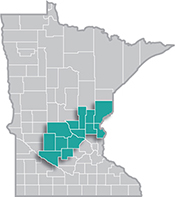 Central Minnesota is a manufacturing stronghold, with several global manufacturing firms operating there.
Central Minnesota is a manufacturing stronghold, with several global manufacturing firms operating there.
The region is especially well known for its expertise in food processing, printing, furniture manufacturing, appliances, machinery and heavy equipment manufacturing.
View our latest blogs on CareerForce. Want the freshest data delivered by email? Subscribe to our regional newsletters.
4/23/2025 11:54:03 AM
Luke Greiner
With many of our nation's largest financial institutions now forecasting the probability of a U.S. recession rising to 40%-50% in the next year, it is worth examining what happened during the Great Recession in Central Minnesota. Although each recession is unique both in the cause and impact, certain sectors were more prone to challenges during the Great Recession of 2007–2009, with significant job losses reshaping the economic landscape. However, amidst these declines, certain industries also demonstrated resilience and growth, offering valuable insights into the region's adaptability.
In order to isolate the effect of the Great Recession, we chose to compare the year prior to the start (2006) with the year after the end (2010). Employers in the region cut 12,370 jobs, a -4.8% drop. Of the 20 main industries, Manufacturing and Construction were hit hardest, accounting for nearly all of the net job losses in the region. Manufacturing declined by almost 18%, shedding close to 7,600 jobs, with subsectors like Apparel Manufacturing (-61%), Computer & Electronic Products (-48%), Textiles (-48%) and Furniture Manufacturing (-52%) suffering the most. Construction faced a staggering 30% decline, erasing over 4,800 jobs. Other sectors also contracted as consumers cut back: Retail Trade lost 7% of its workforce (-2,448 jobs), Accommodation & Food Services declined by 8% (-1,759 jobs), and Mining saw a 34% drop (-134 jobs).
Despite these losses, almost half of the region's major industries actually added jobs. Health Care & Social Assistance stood out with a remarkable growth (17%) due to every component of this sector expanding by more than 10%, including Ambulatory Health Care Services, Hospitals, Nursing & Residential Care Facilities, and Social Assistance. In sum, Health Care added more than 5,300 jobs from 2006 to 2010. Educational Services saw the second largest gain, adding almost 600 jobs despite the recession.
On a smaller scale, Agriculture also grew by 10% (+348 jobs), and Utilities increased by 6% (+139 jobs). At a more detailed level, other notable growth areas included Warehousing & Storage (+128%), Publishing (+33%), Chemical Manufacturing (+28%), Broadcasting (+22%), and Beverage Manufacturing (+22%).

In the midst of job losses, Workforce Development programs played a critical role in helping displaced workers transition out of unemployment into growing industries like Health Care & Social Assistance. This shift highlighted the importance of aligning training initiatives with emerging economic opportunities to foster resilience during downturns. In good economic times or bad, Central Minnesota Jobs & Training Services (CMJTS) and Career Solutions work hard to connect jobseekers with the resources needed to identify a career pathway, continue building and developing their skills, and find the right job.
While predicting future downturns is a fool's errand, we know, without a doubt, that workforce development infrastructure built during times of crisis will continue to play an important role during times of uncertainty. In addition to lessons learned from past downturns, labor market information can help inform strategies to navigate each changing business cycle. We work closely with our workforce development partners to help jobseekers find what they need.
Contact Luke Greiner at luke.greiner@state.mn.us.